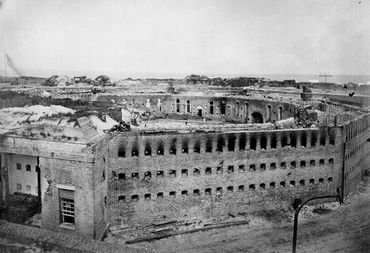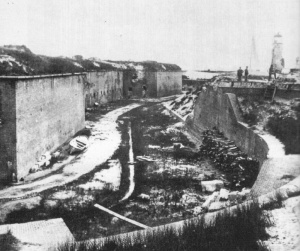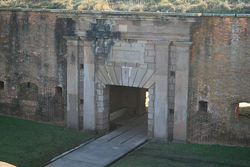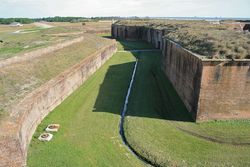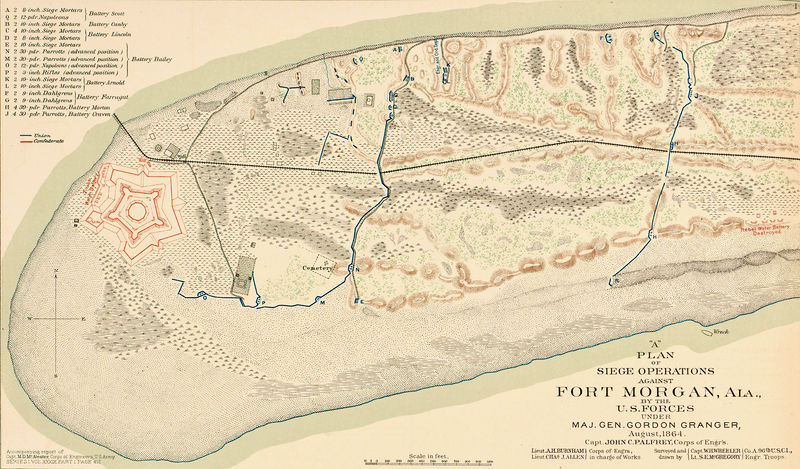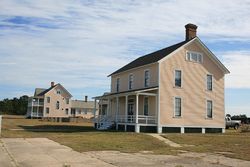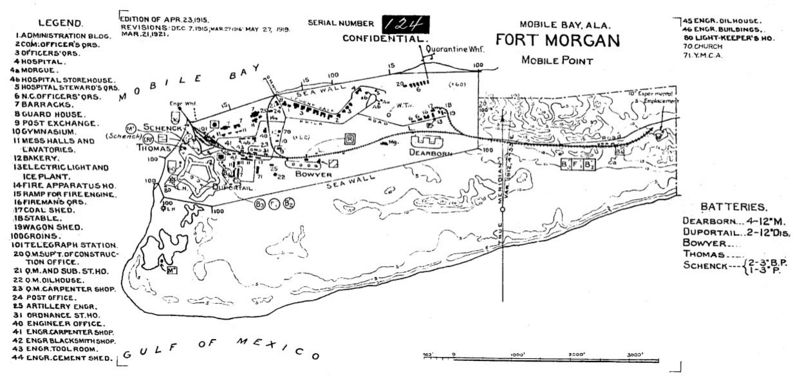Fort Morgan (1)
|
Fort Morgan (1) (1819-1946) - Construction began in 1819 and continued until 1834 on this Third System Masonry fort designed by Simon Bernard. Named after Revolutionary War hero Daniel Morgan in 1833. Abandoned after World War I and reactivated during World War II, it was returned to the State of Alabama after the end of World War II. HistoryPart of the Harbor Defense of Mobile, Alabama. Established to defend the narrow entrance to Mobile Bay, Alabama along with Fort Gaines (1). Fort Morgan was constructed of brick as a regular pentagon with bastions at each of the five corners and a large ten-sided citadel in the center. The three-tiered citadel housed the troops and was the largest of any Third System fort. The seacoast batteries were mounted on the two primary and two secondary fronts of the fort. Other land batteries were placed to protect against assault from the landward side. The entrance to the fort was a tunnel under the gorge protected at both ends by large doors.
U.S. Civil War (1861-1865)At the beginning of the U.S. Civil War in 1861, the Alabama State Militia seized both Fort Gaines and Fort Morgan from Federal troops. Fort Morgan's batteries "mounted in all about forty-five guns, from 8‑inch rifles down to 24‑pounders. Of these only about a dozen were heavy rifled cannon. The majority were old smooth-bores, 8 and 10‑inch Columbiads, and 32‑pounders. The garrison numbered 640 officers and men, who were under the command of Brigadier General Richard L. Page, formerly an officer in the United States Navy." In August 1864 a federal flotilla of 18 ships under Adm. David Farragut arrived off the entrance to Mobile Bay determined to recapture both Fort Gaines and Fort Morgan, enter Mobile Bay, and capture Mobile itself. Farragut first reduced Fort Gaines and forced its surrender on 8 Aug 1864 during the Battle of Mobile Bay. On 9 Aug 1864 Union transport ships landed Union General Gordon Granger and his 2,000 troops at Navy Cove, east of the Fort Morgan. This move enabled Granger to establish a siege line at the rear of the fort and to cut off any escape route for the garrison. General Granger established two siege lines across the slip of land leading to the fort until he was within 200 yards of the glacis on the 21st of August. At this point, he had some 5,000 troops and a number of gun batteries, applying pressure from the land-side. The first gun battery emplaced mounted a pair of 30-pounder Parrott rifles and the last was a 10-gun battery named Battery Bailey mounting two 3" Ordnance rifles, two 12-pounder Napoleons, four 30-pounder Parrot Rifles, and two 10" Siege mortars. That battery was completed on 20 August. Most significant was the emplacement of a total of 14 mortars each able to drop large mortar shells directly into the fort. While the land-side pressure focused on keeping gun crews inside the fort unable to fire their big guns, the Union flotilla surrounded the fort and began a bombardment on the 22nd to reduce the old brick fort. The fort was critically damaged and the central citadel was on fire. The Citadel fire threatened the gunpowder stores and General Page was forced to pour the gunpowder into the water cisterns to save the fort. General Page surrendered the Fort at 2 pm on 23 Aug 1864. During the Battle of Mobile Bay, the Union monitor Tecumseh was sunk by a Confederate torpedo (mine). The Tecumseh struck the mine in the narrow channel in front of the fort blocking the channel and causing the following ships to slow, making them vulnerable to Confederate fire from the fort. The increased danger was the occasion for Adm. Farragut's famous order, "Damn the torpedoes, full speed ahead!", referring to the torpedoes (mines) strung across the channel into Mobile Bay. After the U.S. Civil War the federal garrison was withdrawn and the fort was placed in caretaker status on 31 Dec 1867.
Endicott Period (1890-1910)In March of 1898, the fort was reactivated and garrisoned by Battery I, 1st U.S. Artillery in anticipation of the Spanish American War and as a result of the explosion that sunk the Battleship Maine in Havana Harbor 15 Feb 1898. Construction began on the first Endicott Period battery, Battery Bowyer in 1898. A total of six Endicott Period batteries were built between 1898 and 1901. Only Battery Duportail was built inside the Fort Morgan walls. The Spanish American War was quickly over but the strengthening of coastal defenses continued.
World War I (1917-1918)During World War I Fort Morgan was used as a training base. After World War I Fort Morgan was again deactivated and placed in caretaker status 1 Apr 1923. Subsequently abandoned 15 Oct 1931. World War II (1941-1945)At the onset of World War II the fort was reactivated and manned in April 1942 by Battery F, 50th U.S. Coast Artillery Corps. In 1946, after the close of the War, the fort property was returned to the State of Alabama and became Fort Morgan State Park.
Current Status
See Also:
Sources:
Links:
Visited: 2,5 Oct 2021, 23 Dec 2011, 10 Dec 2009 Picture Gallery
| ||||||||||||||||||||||||||||||||||||||||||||||||||||||||||||||||||||||||||||||||||||||||||||||||||||||||||||||||||||||||||||||||||||||||||||||||||||||||||||||||||||||||||||||||||||||||||||||||||||
